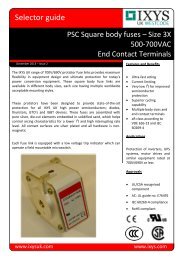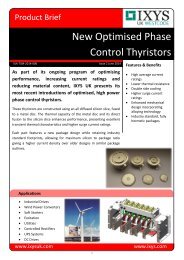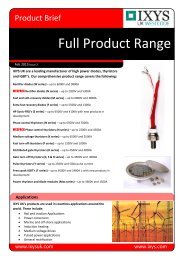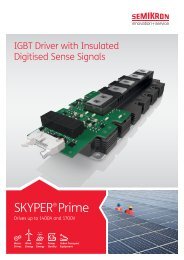isolated current voltage transducers
You also want an ePaper? Increase the reach of your titles
YUMPU automatically turns print PDFs into web optimized ePapers that Google loves.
Other Types of Voltage Transducers Technologies<br />
6 Other types of <strong>voltage</strong> transducer technologies<br />
Two additional <strong>voltage</strong> measurement technologies have been<br />
developed by LEM to achieve differentiated measurement<br />
performance compared to Hall (§ 3.4) or Fluxgate (§ 4.4.4)<br />
based <strong>voltage</strong> <strong>transducers</strong>. The first technology, OptiLEM,<br />
uses fiber optics for the transmission of the <strong>voltage</strong><br />
measurement information, providing a high level of dielectric<br />
isolation. The second technology is the AV-type of <strong>voltage</strong><br />
transducer based on electronic isolation circuitry that also<br />
provides galvanic isolation, but at the component level rather<br />
than using discrete fiber optics.<br />
and transmitted to the secondary side through an optical<br />
link. The same is done with the required data<br />
synchronization signals.<br />
On the secondary side the data stream is converted back<br />
into an analog signal and converted into an output <strong>current</strong><br />
for high noise immunity and easy scaling. A very critical<br />
function of the transducer is to provide a low <strong>voltage</strong> supply<br />
for the components on the primary side, requiring a very<br />
high level of <strong>voltage</strong> isolation and very low capacitive<br />
coupling from primary to secondary. A sine wave signal is<br />
used to minimize noise levels.<br />
6.1 OptiLEM <strong>voltage</strong> <strong>transducers</strong><br />
The OptiLEM <strong>voltage</strong> transducer has been developed to<br />
provide an optimal solution for higher isolation <strong>voltage</strong>s. The<br />
result is an interesting product containing numerous patented<br />
concepts.<br />
The following key attributes are reached with the first <strong>voltage</strong><br />
transducer model:<br />
• <strong>isolated</strong> <strong>voltage</strong> measurements up to 12 kV RMS<br />
• 100 V to 6 kV measuring range<br />
• overall accuracy better than 1.5 %<br />
• bandwidth from DC to 12 kHz<br />
• low stray capacitance between primary and secondary<br />
(less than 10 pF)<br />
• low partial discharge extinction level of 5 kV with < 10 pC<br />
Figure 48: OptiLEM <strong>voltage</strong> transducer<br />
The working principle of the OptiLEM <strong>voltage</strong> <strong>transducers</strong> is<br />
shown in Fig. 47. The primary <strong>voltage</strong> is directly applied to the<br />
transducer primary connections, ±U. An internal resistor<br />
divider network and differential amplifier measure the primary<br />
<strong>voltage</strong> signal. This output is converted to a serial data string<br />
U+<br />
U-<br />
DIFFERENTIAL<br />
AMPLIFIER<br />
12 bits A/D<br />
converter<br />
A<br />
D<br />
SERIAL DATA<br />
OPTIC FIBER<br />
D<br />
A<br />
U<br />
I<br />
M<br />
OPTIC FIBER<br />
SYNCHRONIZATION<br />
OSCILLATOR<br />
+<br />
VOLTAGE REGULATOR<br />
+V<br />
supply<br />
-<br />
-V<br />
PRIMARY SUPPLY<br />
+<br />
0 -<br />
RECTIFIER/ FILTER<br />
HIGH INSULATION<br />
VOLTAGE<br />
TRANSFORMER<br />
SINE<br />
OSCILLATOR<br />
PRIMARY SIDE<br />
SECONDARY SIDE<br />
Figure 47: OptiLEM working principle<br />
39

















